Die subtile Kunst des Nachfassens mit E-Mail-Automatisierung
Wie Sie Ihre potenziellen Kunden so massieren, dass sie automatisch einen F*ck geben.
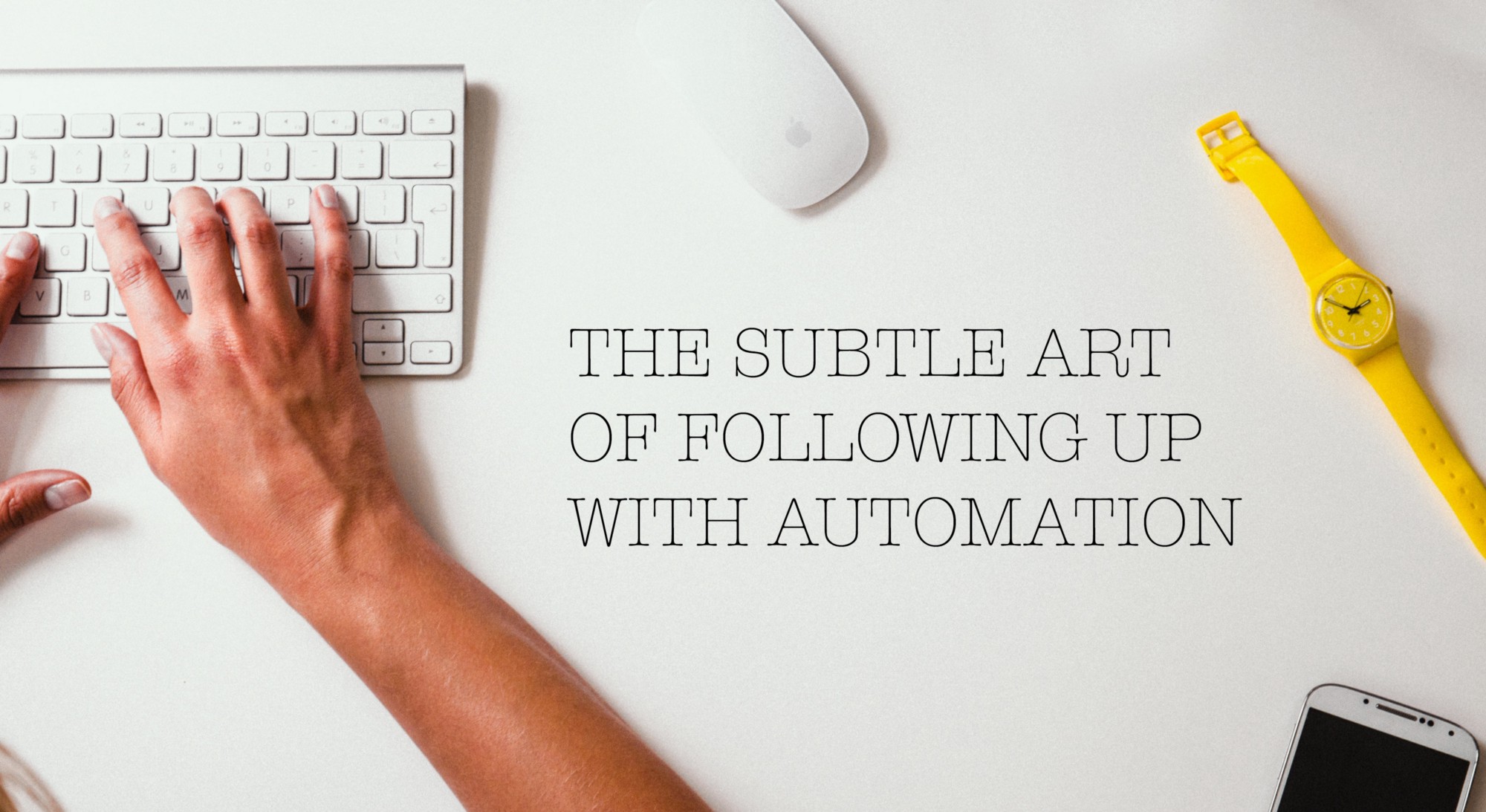
Also.
Sie haben mit cleveren Social-Media-Taktiken und Growth Hacks einige interessante Leads gefunden.
Sie haben sich mit einer fantastischen Kaltakquise-E-Mail an Sie gewandt, die fast wie handgeschrieben aussieht, aber in Wirklichkeit in automatisierten Stapeln verschickt wurde, während Sie schliefen, und zwar mithilfe von Daten und einem Tool zur Automatisierung von Kaltakquise-E-Mails.
Sie haben bei einem Ihrer potenziellen Kunden einen Volltreffer gelandet und er schickt Ihnen eine E-Mail zurück.
Streichen Sie das.
Weil Sie Tausende dieser E-Mails verschickt haben, schicken hunderte Ihrer potenziellen Kunden E-Mails zurück.
Was nun, du Genie?
Wenn Sie eine Antwortrate von etwa 3% haben und die E-Mail-Automatisierung nutzen, um Ihre Reichweite von 10 auf 300 E-Mails pro Tag zu erhöhen, haben Sie jeden Monat 270 neue Leads zum Nachfassen.
Jeder einzelne von ihnen erfordert Ihren Wert, Ihre Pflege, Geduld und Verfügbarkeit, um in ein Geschäft verwandelt zu werden. Tatsächlich zeigen Statistiken, dass 80% der Verkäufe mindestens fünf Nachfassaktionen erfordern, was bedeutet, dass Sie mehr als tausend E-Mails versenden müssen, um all diesen Interessenten die Aufmerksamkeit zukommen zu lassen, die sie verdienen.
Kurz gesagt: Wenn Sie der Aufgabe nicht gewachsen sind, wird die Automatisierung Sie eher unter der Erde begraben, als Sie zu den Sternen schießen.
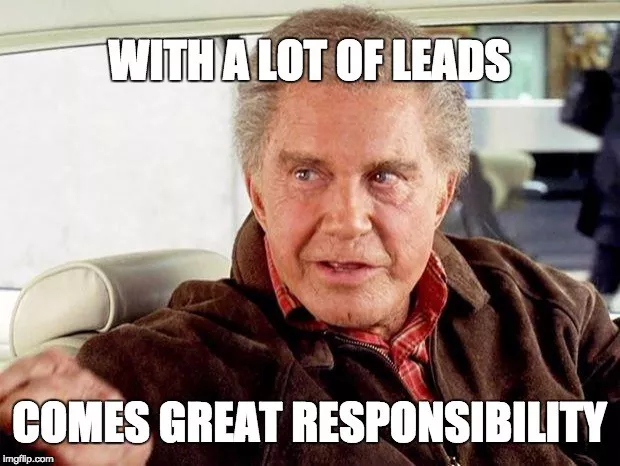
In diesem Beitrag geht es nicht darum, wie wichtig Follow-up ist, und es geht auch nicht nur darum, wie man es macht. Es geht darum, wie man es klug anstellt, wie man ein Maximum an fruchtbaren menschlichen Beziehungen aufbaut, ohne in der eigenen Pipeline zu ertrinken, wie man mit weniger mehr erreicht.

Beginnen wir mit dem "Warum
Warum sich die Mühe machen, nachzufassen?
Nun, weil es funktioniert. Nachfassen bringt Ihnen Umsatz.
Statistiken zeigen, dass 80% der Verkäufe nach mindestens fünf Nachfassaktionen getätigt werden.
Statistiken zeigen auch, dass 44% der Vertriebsmitarbeiter nach der ersten Ablehnung aufgeben.
Es kommt noch besser:
- 22% stellt das Follow-up nach zwei Ablehnungen ein
- 14% beenden die Nachverfolgung nach drei
- 12% beenden die Weiterverfolgung nach vier
👉🏼 92% der Vertriebsmitarbeiter geben vor dem entscheidenden fünften Follow-up auf.
Sie haben richtig gelesen: Sie können 92% von Vertriebsmitarbeitern schlagen, indem Sie einfach hartnäckig sind.
Das ist jedoch leichter gesagt als getan. Die meisten Vertriebsmitarbeiter wissen, dass sie konsequent nachfassen sollten, haben aber Angst davor, dies zu tun. Aus Angst, abgelehnt zu werden.
Wenn man zahllose E-Mails an jemanden schickt, um dann immer wieder ignoriert oder abgelehnt zu werden, fühlt man sich lästig, und niemand will lästig sein.
Aber: Was haben Sie eigentlich zu verlieren?
Der erste Kontakt ist einfach. Sie haben die Hürde genommen, auf jemanden zuzugehen. Sie haben das Treffen arrangiert, den Anruf getätigt, die E-Mail verschickt. Sie haben Ihren Job gemacht, Sie fühlen sich gut dabei. Jetzt liegt es an ihnen, oder?
Das ist der Fehler, den Sie machen.
Machen Sie sich klar, dass es an Ihnen liegt, ob Sie eine Antwort von Ihrem potenziellen Kunden erhalten. Sie haben keinen Anspruch auf irgendetwas, und das Wartespiel wird Sie nicht weiterbringen.
Warum nachfassen? Weil es gut fürs Geschäft ist.
Sie brauchen ein CRM-Tool
Bevor wir Sie in einen E-Mail-Follow-up-Superhelden verwandeln, müssen wir Sie auf den Fahrersitz setzen.
Denken Sie daran, dass wir davon ausgehen, dass Sie die Automatisierung für die personalisierte Ansprache in großem Umfang nutzen. Alle Zaubertricks nützen nichts, wenn Sie nicht in der Lage sind, die Antwortwellen zu bewältigen, die Ihre automatisierten Outbound-Kampagnen auslösen.
Hier betreten wir das Reich der CRM-Software. Ein Tool, das es Ihnen ermöglicht, menschliche Beziehungen zu einer Vielzahl von Interessenten gleichzeitig aufzubauen.
Bei Salesflare sind wir der Meinung, dass die meisten CRM-Tools das Gegenteil bewirken: Sie zwingen Sie dazu, Anrufe zu protokollieren, Kontakte zu aktualisieren, E-Mails anzuhängen und andere sinnlose Verwaltungsarbeiten zu erledigen, für die Menschen eigentlich nicht vorgesehen sind. Sie werden so von dem abgehalten, was wirklich wichtig ist: dem Gespräch mit potenziellen Kunden.
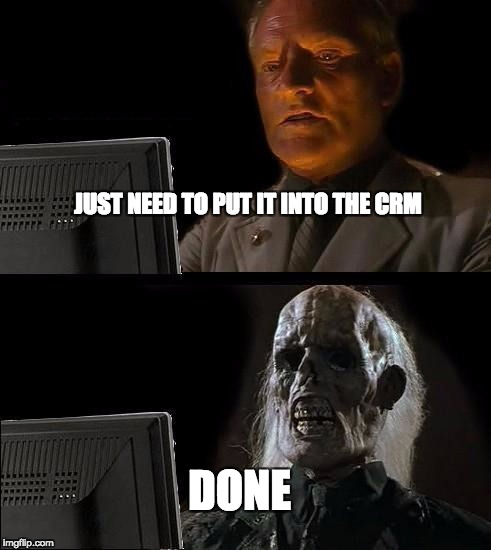
Wir haben Salesflare als ein Tool entwickelt, das Ihnen hilft, ohne dass Sie ihm zuerst helfen müssen. Etwas, das mehr Verkaufsassistent als Tabellenkalkulation ist.
In Zukunft werden wir das Salesflare als CRM-Referenz in der Folgegleichung verwenden, ohne die Taktik ausschließlich darauf auszurichten.
Automatisieren Sie alles, was Sie nicht braucht
Wenn Sie Ihre Zeit und Ihr Talent ganz auf die Nachbereitung und den Aufbau von Beziehungen konzentrieren wollen, müssen Sie sich zunächst von allem befreien, was Sie davon abhält.
Die Technologie ist inzwischen so weit ausgereift, dass sie nicht mehr von Erwachsenen beaufsichtigt werden muss. Machen Sie sich das zunutze. Lassen Sie die Roboter die Roboterarbeit erledigen, damit Sie sich auf die wichtigen Dinge konzentrieren können.
Sie können so ziemlich alles bis zu dem Punkt automatisieren, an dem Sie im Gespräch gebraucht werden. Keine Programmierung erforderlich, eine Kombination aus Salesflare und Zapier genügt.

Zapier ermöglicht es Ihnen, SaaS-Anwendungen miteinander zu verbinden und sie in autonomen Abläufen zusammenarbeiten zu lassen. Die Idee ist ziemlich einfach: Jede App hat eine Reihe von Auslösern und eine Reihe von Aktionen. Sie müssen nur angeben, welcher Auslöser der einen Anwendung welche Aktion in der anderen auslösen soll.
Eine ausgelöste Aktion wird als Zap bezeichnet. Je nachdem, wie komplex der Ablauf ist, benötigen Sie einen oder mehrere Zaps, damit er funktioniert.

Das beste Beispiel hierfür wäre die automatische Übertragung von Leads aus Ihrem Terminplaner in Ihr CRM.
Das würde dann so aussehen:
- Sie versenden personalisierte E-Mails in großem Umfang mithilfe der E-Mail-Workflows in Salesflare. (Möchten Sie sehen, wie? Hier zeigt ein Kunde, wie er die E-Mail-Workflows für die Akquise nutzt).
- In Ihrer E-Mail schlagen Sie ihnen vor, über den persönlichen Link Ihres Terminplaners (wie YouCanBook.me oder Calendly) einen Termin mit Ihnen zu vereinbaren.
- Sie richten Zapier ein, um automatisch ein Konto/Unternehmen, einen Kontakt und eine Verkaufschance in Ihrem CRM Salesflare zu erstellen. Sie können sogar automatisch eine Aufgabe zur Nachverfolgung erstellen und weitere Informationen in benutzerdefinierten Feldern oder einer internen Notiz speichern. Verwenden Sie einfach Ihre Fantasie. 🤯
Jetzt müssen Sie nur noch eine Outbound-Kampagne starten, und Ihre Vertriebs-Pipeline füllt sich automatisch mit Leads, die Sie dann weiterverfolgen können.
Natürlich müssen Ihre Leads nicht nur aus E-Mails stammen. Sie können auch Zapier verwenden, um Leads aus Formularen (z. B. Typeform, Google Forms), Facebook Lead Ads oder Chatbots (Collect.chat, ManyChat, Chatfuel) in Ihr CRM zu übertragen. Stöbern Sie in unseren Zapier-Vorlagen für Inspiration.
Wie man beim Follow-up gewinnt
Von jetzt an sind Sie allein verantwortlich.
Wir haben es bereits erwähnt: Die einzige Superkraft, die Sie brauchen, ist Beständigkeit. Man gewinnt das Rennen, indem man immer weiterläuft, nicht indem man schnell ist.
Wie kann man beim Nachfassen gewinnen? Bleiben Sie dran, bis Sie eine Antwort erhalten, egal wie diese lautet. Ein "Nein" zu erhalten ist keine Niederlage. Damit können Sie zum nächsten Projekt übergehen und Ihre Zeit und Ihre Talente dort investieren, wo sie gebraucht werden.
Das ist die Einstellung, die Sie brauchen, um ins Spiel zu kommen. Fügen Sie nun die folgenden 11 Zutaten zur Formel hinzu, um ein Meister des Spiels zu werden.
1. Ausführung ist etwas, Timing ist alles
Mit "Antwort" meine ich wirklich Antwort. Dass Sie keine E-Mail zurückbekommen, zählt nicht und sollte Sie nicht davon abhalten.
Zu oft gehen Verkäufer davon aus, dass Schweigen ein Zeichen von Ablehnung ist, während es in Wirklichkeit nur ein schlechtes Timing ist.
Zunächst einmal kann es sein, dass Ihre E-Mail in der Unordnung und dem Durcheinander untergegangen ist. Die Verwendung der E-Mail-Verfolgung kann hier etwas Licht ins Dunkel bringen. Wenn Sie die E-Mail-Seitenleiste von Salesflare für Google Mail oder Outlook oder E-Mails aus dem CRM selbst verwenden, können Sie feststellen, ob eine E-Mail geöffnet wurde oder nicht.
Selbst wenn der Empfänger Ihre E-Mail geöffnet hat, gibt es immer noch mehrere mögliche Gründe, warum ein potenzieller Kunde nicht auf Ihre E-Mail antwortet:
- sie nicht verfügbar sind (Krankheit, Reisen, persönliche Probleme)
- sie sind gerade mit etwas anderem beschäftigt
- sie haben einfach vergessen zu antworten
Was auch immer es ist, nehmen Sie es nicht persönlich. Die Annahme, dass Sie keine E-Mail zurückbekommen haben, weil Sie abgelehnt wurden, ist eine verhängnisvolle Denkweise. Ändern Sie die Situation: Nehmen Sie an, dass der Zeitpunkt einfach nicht richtig war, und versuchen Sie es erneut.
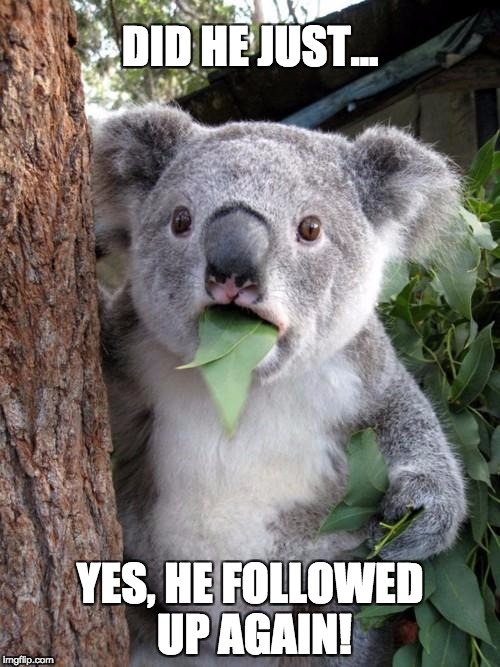
Vielleicht haben sie dich ignoriert, weil sie nicht interessiert sind, vielleicht auch nicht.
Das Einzige, was Sie mit Sicherheit wissen, ist, dass Sie es nicht wissen. Verlassen Sie das "Vielleicht"-Land und bleiben Sie dran, bis Sie es wissen. Die einzigen Ergebnisse, mit denen Sie sich zufrieden geben sollten, sind "Ja" und "Nein".
Im Spiel der Nachbereitung ist ein "Nein" kein Verlust, sondern ein Gewinn. Wenn Ihnen jemand mitteilt, dass er nicht interessiert ist, können Sie Ihre Bemühungen auf den nächsten Interessenten konzentrieren. Die einzige Möglichkeit, bei der Nachbereitung zu verlieren, besteht darin, bei "vielleicht" stehen zu bleiben.
2. Klarheit über das Gefallenwerden stellen
Warum ist es so schwierig, über das Schweigen hinauszugehen und weiterzuverfolgen, bis man jemanden erreicht hat?
Sie haben Angst, lästig zu sein.
Nun, raten Sie mal: Sie sind nicht mehr in der High School. Beliebt zu sein, wird Ihr Unternehmen nicht wachsen lassen. Der Umsatz schon.

Anders ausgedrückt: Streben Sie an, dass sieben Menschen Sie nicht mögen und drei Menschen mit Ihnen Geschäfte machen, anstatt zehn Menschen, die Sie mögen und null, die mit Ihnen Geschäfte machen.
Die sieben, die sich von Ihnen abwenden, weil Sie versuchen, ihnen einen Nutzen zu bringen, verdienen Ihre Energie ohnehin nicht. Investieren Sie diese Energie in die Menschen, die wirklich wichtig sind.
3. Wissen, wann man aufhören muss
Manche Menschen nutzen das Schweigen, um Ihnen mitzuteilen, dass sie nicht interessiert sind.
Als Faustregel gilt: Fünf Kontaktaufnahmen ohne Antwort sind gleichbedeutend mit "Nein". Sie können davon ausgehen, dass die Person nicht an Ihrem Angebot interessiert ist, und Ihre Energie in jemand anderen investieren.

Eine weitere gute Idee ist es, einen Schritt zurückzutreten, wenn es um den Verkauf geht, und zuerst die Meinung der Nutzer zu einem bestimmten Thema einzuholen. Das kann eine persönliche Frage sein oder etwas formeller und automatisierter, indem Sie eine spezielle Plattform für Nutzerfeedback wie Mopinion nutzen, wo Sie E-Mail-Feedback sammeln können.
4. Präsent sein, ohne sich anzubiedern
In welchen Abständen sollten Sie nach dem Versand Ihrer ersten E-Mail nachfassen?
Beginnen Sie stark und verringern Sie die Häufigkeit mit der Zeit. Je länger ein Interessent nicht antwortet, desto wahrscheinlicher ist es, dass die Zeitspanne, in der das Timing nicht stimmt, erheblich ist.
Hier ist ein allgemeiner Überblick, von dem Sie ausgehen können:
- Tag 1: 1. E-Mail-Follow-up
- Tag 3: 2. Nachbereitung
- Tag 7: 3d-Follow-up
- Tag 14: 4. Nachbereitung
- Tag 25: 5. Nachbereitung
- Nach: einmal im Monat
Wenn Sie eine Verbindung zu Ihrem Interessenten aufgebaut haben, ohne dass dieser sofort an Ihrem Produkt interessiert ist, ist es dennoch sinnvoll, sich etwa einmal im Monat zu melden, um die Beziehung aufrechtzuerhalten. Spielen Sie das lange Spiel. Ihr Netzwerk ist Ihr Kapital, Sie wissen nie, welche Vorteile eine Verbindung mit sich bringen kann.
Bei der Kaltakquise können Sie dies mithilfe von Sequenzen in Ihrem E-Mail-Automatisierungstool leicht automatisieren.
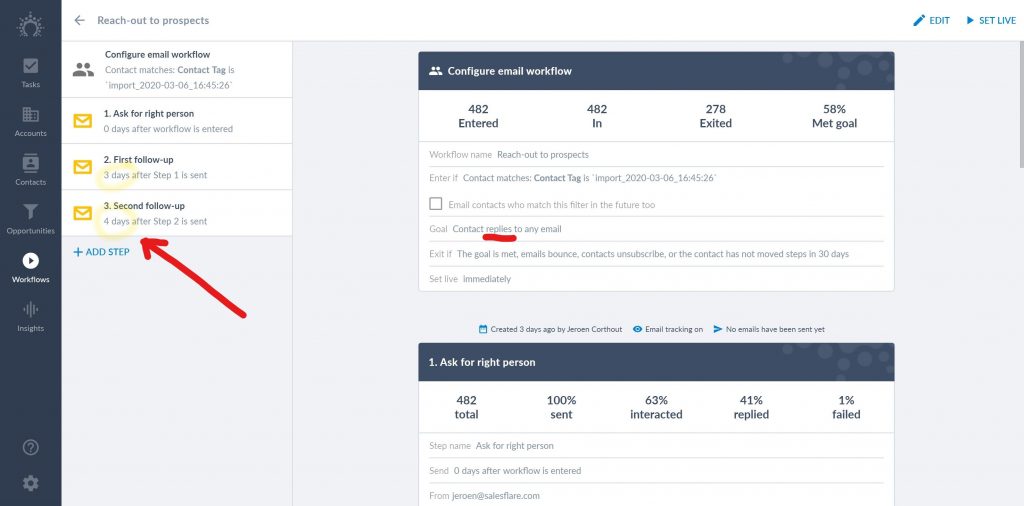
Sie können Ihre Nachverfolgungsroutine in einem Salesflare-E-Mail-Workflow perfekt nachbilden und ihn sogar noch etwas flexibler gestalten. Angenommen, in Ihrer E-Mail befindet sich ein Link zu Ihrem Kalender, über den potenzielle Kunden einen Anruf bei Ihnen buchen können: Sie können die Sequenz auch abbrechen, wenn sie auf diesen Link klicken.
5. Verwenden Sie Erinnerungshilfen
Nachfassaktionen sind nicht nur bei der Kaltakquise erforderlich. Es kann sein, dass Sie mit einem potenziellen Kunden bereits einige Fortschritte gemacht haben, aber bevor Sie es merken, werden die Leitungen wieder kalt. Es ist Ihre Aufgabe, die Beziehung aufrechtzuerhalten. Denken Sie daran: Sie haben keinen Anspruch auf irgendetwas.
"Das muss ich mir nicht aufschreiben, das merke ich mir."
- Nein, das werden Sie nicht.
Ihr Gehirn ist kein Tresor, in dem Sie Daten speichern können, dafür gibt es Technologie. Sie werden auf jeden Fall Fehler machen, wenn Sie mehrere Gelegenheiten gleichzeitig im Auge behalten müssen. Sie werden vergessen, nachzufassen, und Ihnen entgehen Verkäufe.
Hier kommt Ihr CRM ins Spiel. Es zeigt Ihnen an, wann Sie nachfassen sollten, indem es einfache Aufgaben und/oder Erinnerungen erstellt, damit Sie sich auf das Wesentliche konzentrieren können: das Schreiben überzeugender E-Mails zum Aufbau von Beziehungen.
Um eine Aufgabe in Salesflare zu erstellen, verwenden Sie das obere Feld auf dem Aufgabenbildschirm.
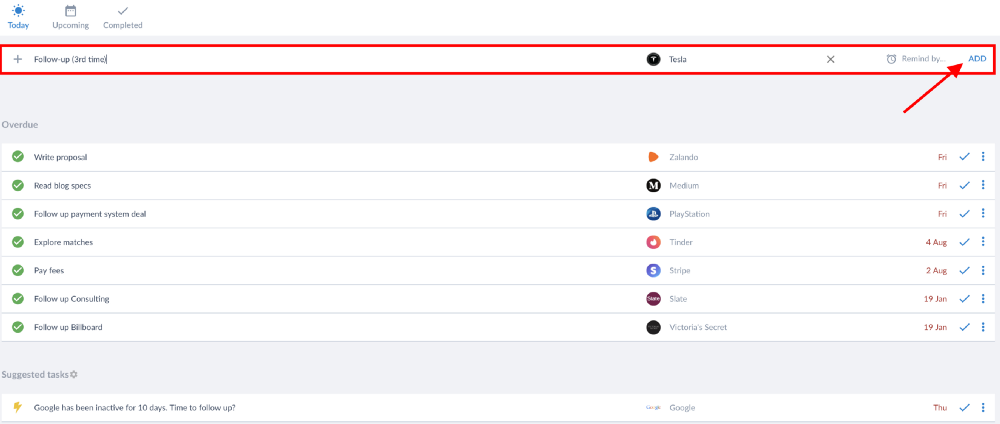
Wir wären nicht Salesflare, wenn wir nicht einige Automatisierungsfunktionen in petto hätten. Neben den Aufgaben sorgen wir auch dafür, dass Sie mit automatischen Inaktivitätserinnerungen am Ball bleiben. Diese werden nach 10 Tagen Inaktivität bei Opportunities in Ihrer Vertriebspipeline ausgelöst.
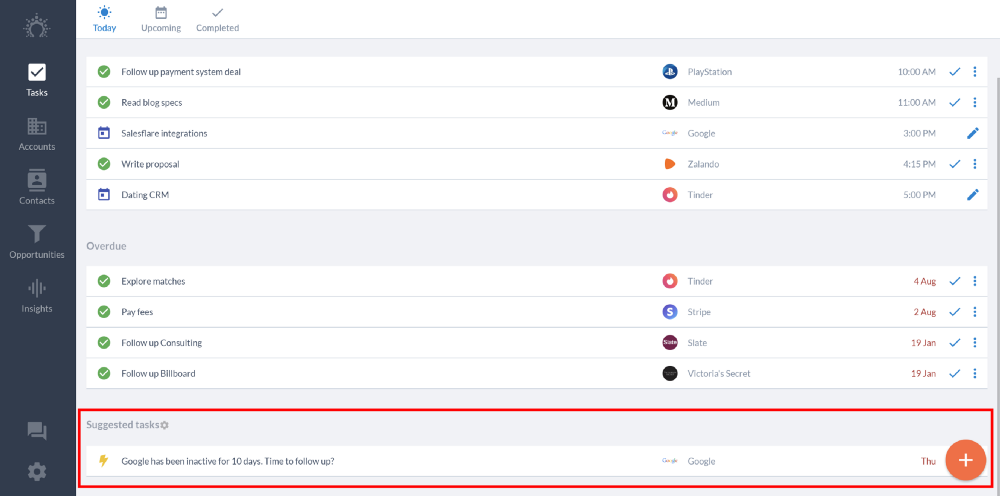
10 Tage ist die Standardeinstellung. Sie können diese Zeitspanne an die einzelnen Phasen Ihrer Vertriebs-Pipeline anpassen. Gehen Sie einfach zu Einstellungen > Pipelines anpassen, klicken Sie zum Bearbeiten auf den Bleistift und legen Sie eine benutzerdefinierte Anzahl von Tagen für Inaktivitätserinnerungen fest.
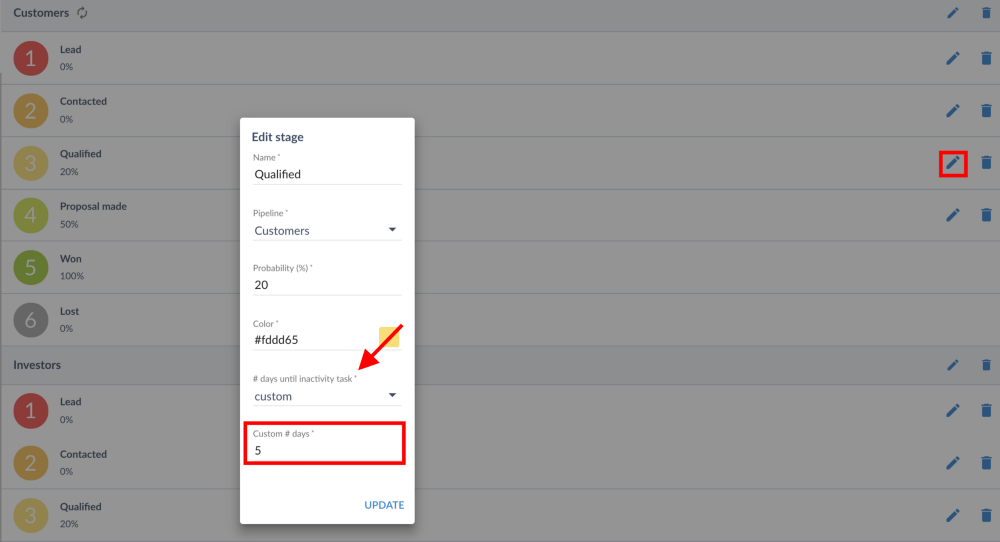
Es gibt noch mehr...
In Salesflare können Sie auch automatische Follow-up-E-Mails auf der Grundlage von Auslösern, wie z. B. Stufenwechsel, verschicken.
Beispiele:
- Ein Lead hat auf Ihre Kaltakquise-E-Mail geantwortet und einen Anruf bei Ihnen gebucht. Da dieser Lead automatisch von Ihrem Terminplaner in Ihre Vertriebs-Pipeline in Ihrem CRM übertragen wird, wird automatisch eine E-Mail zur Bestätigung des Anrufs verschickt. Machen Sie es zu etwas Besonderem, indem Sie einen relevanten Inhalt versenden.
- Der Anruf verlief gut und Sie bringen den Lead in die nächste Phase Ihrer Pipeline. Dies löst eine E-Mail aus, in der Sie Ihren Lead in Ihre Facebook-Community einladen, um ihm das Gefühl zu geben, etwas Besonderes zu sein.
- Sie haben sich mit einem Lead auf Bedingungen geeinigt, und wenn er in die nächste Phase Ihrer Pipeline übergeht, wird eine automatische Angebots-E-Mail an ihn gesendet.
- Sie verkaufen Saas. Die Testphase eines Leads ist abgelaufen, ohne dass er etwas unternommen hat, um zu bezahlen. Wenn er in die "Verloren"-Phase eintritt, wird eine E-Mail ausgelöst, um ihn davon zu überzeugen, ein Abonnement abzuschließen oder zumindest seine Testphase zu verlängern.
6. Es muss nicht immer eine E-Mail sein
Nachfassen und E-Mail gehen Hand in Hand, aber es gibt noch mehr zu bedenken.
Die E-Mail ist zwar nach wie vor das Rückgrat der Geschäftskommunikation, aber andere Medien können in Bezug auf Zustellbarkeit, Reaktionsschnelligkeit und Gesamtwirkung auf den potenziellen Kunden mehr bieten.
Das lange Spiel: E-Mail
Die E-Mail ist die sichere und zuverlässige Option. Sie ermöglicht es Ihnen, Ihren Interessenten mehrmals sanft anzustupsen, ohne aufdringlich zu sein. Sie überlassen dem Interessenten die Kontrolle darüber, wann und wie er antwortet, aber es kann auch lange dauern, bis Sie wirklich durchdringen und Ihre Ziele erreichen.
Für eine schnellere Antwort: Telefonanruf
Im Vergleich zur E-Mail ist ein Telefonanruf schwerer zu ignorieren. Es ist wahrscheinlicher, dass die Leute zum Telefon greifen, als dass sie innerhalb von 2 Minuten auf Ihre E-Mail antworten.
Aus demselben Grund sind Telefonanrufe aufdringlicher als E-Mails. Wir alle ziehen es vor, Dinge in unserer eigenen Zeit zu erledigen, und Folgeanrufe am Telefon passen nicht wirklich dazu. Das Risiko, ein "Vielleicht" in ein "Nein" zu verwandeln, ist bei Telefonanrufen höher als bei E-Mails, weil die Chance, als lästig zu erscheinen, größer ist.
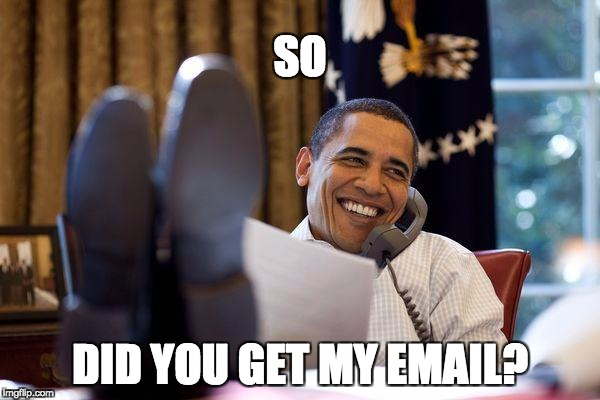
Ob man lästig ist oder nicht, hängt immer von einem selbst ab. Es ist ein Unterschied, ob man jemanden einmal oder zehnmal am Tag anruft. Das erste nennt man Interesse zeigen, das zweite Stalking. Sie sind gewarnt worden.
Sie können nach VoIP-Telefonsystemen für Unternehmen Ausschau halten und zahlreiche automatisierte Funktionen wie automatische Textantworten nutzen, um die Kaltakquise weniger zeitaufwändig zu gestalten. Allerdings haben wir (noch) keine Roboter, die unsere Telefonanrufe erledigen, so dass die beste Taktik im Moment darin besteht, strategische Erinnerungen zu setzen und richtige Skripte für Kaltakquise zu verwenden.
Der Kompromiss: SMS
Wenn Ihre potenziellen Kunden zu lange brauchen, um E-Mails zu beantworten, und nicht zum Telefon greifen, sollten Sie es mit SMS versuchen. Dieses Medium ist nicht so überladen wie E-Mails und weniger aufdringlich als Telefonanrufe, was es sehr effektiv macht, um die Aufmerksamkeit Ihrer Interessenten zu gewinnen.
Sie können den Versand von SMS an Ihre potenziellen Kunden automatisieren, ähnlich wie wir zuvor den Versand von E-Mails automatisiert haben, indem Sie Ihr CRM mit einer der vielen verfügbaren SMS-Versand-Apps mit Zapier verknüpfen.
Willkommen im 21. Jahrhundert: soziale Medien
Die Menschen nutzen zunehmend soziale Medien und ihre Chat-Funktionen, um zu kommunizieren, nicht nur im Privatleben. Jeden Tag werden sowohl meine LinkedIn- als auch meine Facebook-Messenger-Apps mit neuen eingehenden Nachrichten aus der ganzen Welt beleuchtet.
Es ist sinnvoll, eine virtuelle Beziehung in den sozialen Medien aufzubauen, sobald Sie und Ihr Interessent einen freundlichen Erstkontakt hergestellt haben. Wenn Sie Ihrem Interessenten auf Twitter folgen und sich mit ihm auf LinkedIn verbinden, verringert sich die Distanz in Ihrer gegenseitigen Beziehung, insbesondere wenn Sie sich als vertrauenswürdige Person etablieren können, indem Sie auf diesen Plattformen einen Mehrwert bieten.
Wenn Sie ihnen keine Verkaufsargumente ins Gesicht schleudern. Aber ich gehe davon aus, dass Sie das jetzt schon wissen.

Social Selling funktioniert, weil die Kommunikation auf sozialen Plattformen in der Regel sehr viel schneller, informeller und persönlicher ist. Es ist einfacher, sich hier mit jemandem anzufreunden als per E-Mail, und wissen Sie was: Freunde kaufen von Freunden - Menschen, die sie kennen, mögen und denen sie vertrauen.
Der Aufbau von Beziehungen zu Ihren potenziellen Kunden in den sozialen Medien hat wenig bis gar keine Nachteile, ganz gleich, ob es sich um einen persönlichen Chat oder um das Versenden von kleinen Stößen durch das Liken und Teilen von Beiträgen handelt - das Ausmaß, in dem Sie dies tun können, hängt jedoch von der Branche, der Unternehmensgröße, der Rolle und dem Alter des potenziellen Kunden ab. Sechzigjährige Manager großer Wirtschaftsprüfungsunternehmen sind weniger zum Chatten aufgelegt als fünfundzwanzigjährige Marketingexperten von Start-ups.
In Salesflare werden Ihre Kontakte automatisch mit Konten in sozialen Medien angereichert, so dass Sie von Ihrem CRM direkt zu deren LinkedIn-Profilen gelangen können.
Weitere Anregungen zum Thema Social Selling finden Sie in unseren Playbooks für LinkedIn und Facebook.
Damit sich Ihr Interessent besonders fühlt: handschriftliche Notizen
Im Vertrieb und im Marketing gilt: Je öfter eine Taktik angewendet wird, desto mehr lässt ihre Wirkung nach. Der Grund, warum E-Mails im Laufe der Jahre an Wirksamkeit verloren haben, ist, dass wir täglich Hunderte von ihnen erhalten. Um die Aufmerksamkeit Ihres Kontakts wirklich zu erregen, sollten Sie etwas tun, das heraussticht.
Im Laufe der Zeit führen alle Marketingstrategien zu miserablen Klickraten.
Wir waren froh, dass wir aus Gründen der Effizienz die Briefe durch E-Mails ersetzt haben. Briefe zu schreiben kostet Zeit, sie zu versenden möglicherweise noch mehr. Die E-Mail war wegen ihrer Schnelligkeit, Skalierbarkeit und Effizienz ein Geschenk des Himmels. Heute vermissen wir handgeschriebene Briefe aus genau denselben Gründen. Sie haben etwas Besonderes und Authentisches an sich. Weil so wenige Briefe verschickt werden, ist das Erhalten eines Briefes wieder zu einem einzigartigen Erlebnis geworden.
Es mag kontraintuitiv klingen, aber Sie können dies in großem Maßstab tun. Maillift ist ein Dienst, der Ihre handgeschriebenen Briefe für Sie schreibt. Er verfügt über eine Zapier-Integration, so dass Sie dies sogar automatisieren können.
Nichts geht über das echte Leben
"Ich war gerade in der Gegend und dachte, ich schaue mal schnell vorbei, um zu sehen, was los ist."
Es ist einer der ältesten Tricks der Welt, und es ist nicht schwer zu erkennen, warum.
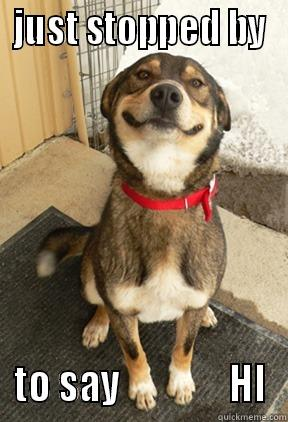
Wenn Sie Eindruck schinden und eine echte Antwort bekommen wollen: Gehen Sie hin. Es gibt keinen Versuch, es geht um Leben und Tod.
7. Verfolgen Sie einen persönlichen Ansatz
Der Schlüssel zum Erfolg bei der Nachfassaktion oder jeder anderen Verkaufs-/Marketingtaktik, die Skalierung und Automatisierung beinhaltet, liegt darin, Ihrem Interessenten das Gefühl zu geben, dass Sie persönlich an der Lösung seiner Probleme beteiligt sind.
Das beginnt schon bei der ersten Kontaktaufnahme. Geben Sie sich nicht mit dem Vornamen zufrieden, sondern stellen Sie sicher, dass Ihr Wert und Ihre Botschaft auf die Personen zugeschnitten sind, an die Sie Ihre E-Mails senden. Funktion, Branche, Unternehmensgröße und geografische Lage sind alles Variablen, die Sie bei der Formulierung Ihrer Nachricht berücksichtigen können. Wenn Sie es wirklich auf die Spitze treiben wollen, nutzen Sie ein Tool wie CrystalKnows, um die Persönlichkeitstypen Ihrer potenziellen Kunden zu ermitteln und verschiedene Arten von Texten zu erstellen, damit Ihre Botschaft optimal ankommt.
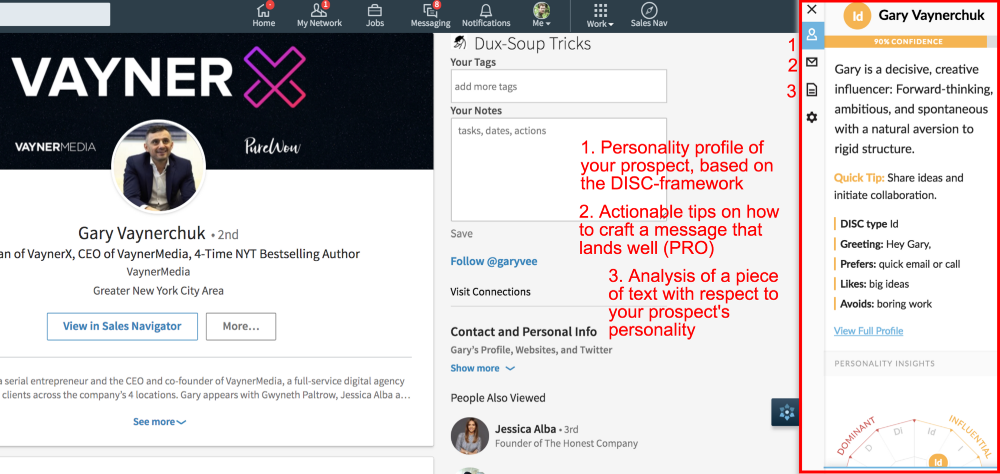
Sie können die Daten von Crystal nutzen, um eine Vielzahl von auf die Persönlichkeit abgestimmten Kaltakquise-E-Mails zu erstellen und/oder sie in Ihren Follow-ups zu verwenden, sobald ein Lead in Ihre Vertriebspipeline gelangt ist. Wenn Sie wissen möchten, wie Sie die Beschaffung von Persönlichkeitsdaten aus LinkedIn-Profilen mit Crystal automatisieren können, besuchen Sie mich auf Messenger.
Von dem Moment an, in dem Sie sich im Follow-up-Modus befinden, kommt es auf den Kontext an. Um dies richtig zu machen, müssen Sie Ihr ganzes Einfühlungsvermögen und Ihre ganze Sorgfalt aufbringen.
Ob Sie zwei- oder siebenmal nachfassen, ob Sie es jeden Tag oder jede Woche tun, ob Sie sich auf E-Mails beschränken oder verschiedene Medien nutzen - alles hängt von der Situation ab, in der sich Ihr Interessent befindet, sowie von der Beziehung und den Interaktionen, die Sie mit ihm hatten. Es ist alles eine Frage des Kontextes.
Mit einem CEO eines Fortune-500-Unternehmens geht man nicht auf die gleiche Weise um wie mit einem jungen Marketer eines SaaS-Start-ups. Der erste bekommt täglich Tausende von E-Mails, der zweite antwortet wahrscheinlich innerhalb von zehn Minuten und schickt Ihnen dann eine Kontaktanfrage auf LinkedIn.
8. Kurz, bündig, prägnant und spezifisch halten
Verschwenden Sie keine Zeit. Nicht Ihre und nicht die Ihres Interessenten.
Wir wissen, dass Sie von Ihrem Produkt begeistert sind, aber wenn Sie in drei langatmigen Absätzen beschreiben, warum das so ist, wird Ihr Interessent nicht das gleiche Gefühl bekommen. Vielleicht lesen sie es nicht einmal. Wenn ich eine E-Mail öffne und einen langen Text sehe, ist mein Reflex, sie sofort wegzuwerfen. Ich kann nichts dafür, das passiert einfach.
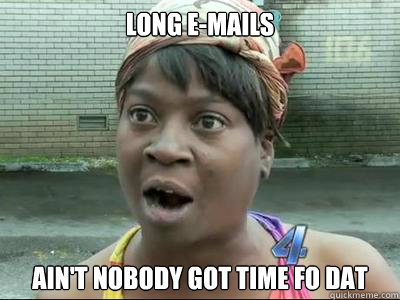
Sie können die Gefühle und Überzeugungen der Menschen weder erzwingen noch kontrollieren. Wenn Sie sich zu sehr in Produktanpreisungen verlieren, zeugt das von mangelndem Einfühlungsvermögen und wird Ihren Interessenten eher abschrecken als ihn anziehen. Kommen Sie auf den Punkt, sprechen Sie den Schmerz oder das Problem an, mit dem sie zu kämpfen haben, und zeigen Sie, wie Sie dieses Problem auf eine Weise lösen können, die ihre Neugierde weckt.
Bei dieser kleinen Interaktion hier geht es nicht um Sie, sondern um den Empfänger und wie Sie ihm helfen können. Widmen Sie Ihre Worte einer Geschichte, in der Ihr Empfänger der Held ist, und machen Sie sie so fesselnd, dass er wissen will, was als Nächstes kommt - bringen Sie ihn dazu, auf die CTA zu klicken, die ihn auf Ihre Website führt oder einen Anruf mit Ihnen vereinbart.
9. Helfen Sie Ihrem Interessenten mit Call-To-Actions weiterzukommen
CTAs sind entscheidend, um einen stetigen Fluss hin und her zu gewährleisten. Sie sollten mit jeder Folge-E-Mail, die Sie versenden, ein Ziel verfolgen und es Ihrem Interessenten leicht machen, dieses Ziel zu erreichen. Es ist nicht an ihnen, herauszufinden, was als nächstes kommt.

Fordern Sie sie auf, Ihre Testversion zu starten, bieten Sie einen Download Ihres neuesten Ebooks an, senden Sie einen Link zu Ihrem Kalender, laden Sie sie in Ihre Facebook-Gruppe ein. Sie sollten eine klare Vorstellung davon haben, was Sie in welcher Phase des Verkaufstrichters erreichen wollen, und Sie sollten spezifische CTAs haben, um Ihre potenziellen Kunden zu veranlassen, in diesem Trichter weiterzugehen.
10. Eine Prise Humor hinzufügen
Nur wenige Dinge auf dieser Welt sind so ansteckend und verbindend wie gute Laune.
Wenn Sie selbst schon einmal verfolgt wurden, wissen Sie, wie wenig Wirkung die einmillionste "Ich wollte mich nur mal melden"-E-Mail hat. Aber was ist, wenn die Person auf der anderen Seite Spongebob Schwammkopf hinzufügt, um die Langeweile zu durchbrechen?

Oder diese ungeduldige Giraffe.

Das beste Beispiel für eine lustige E-Mail-Follow-up, das mir je begegnet ist, ist die E-Mail mit den kleinen Entchen:
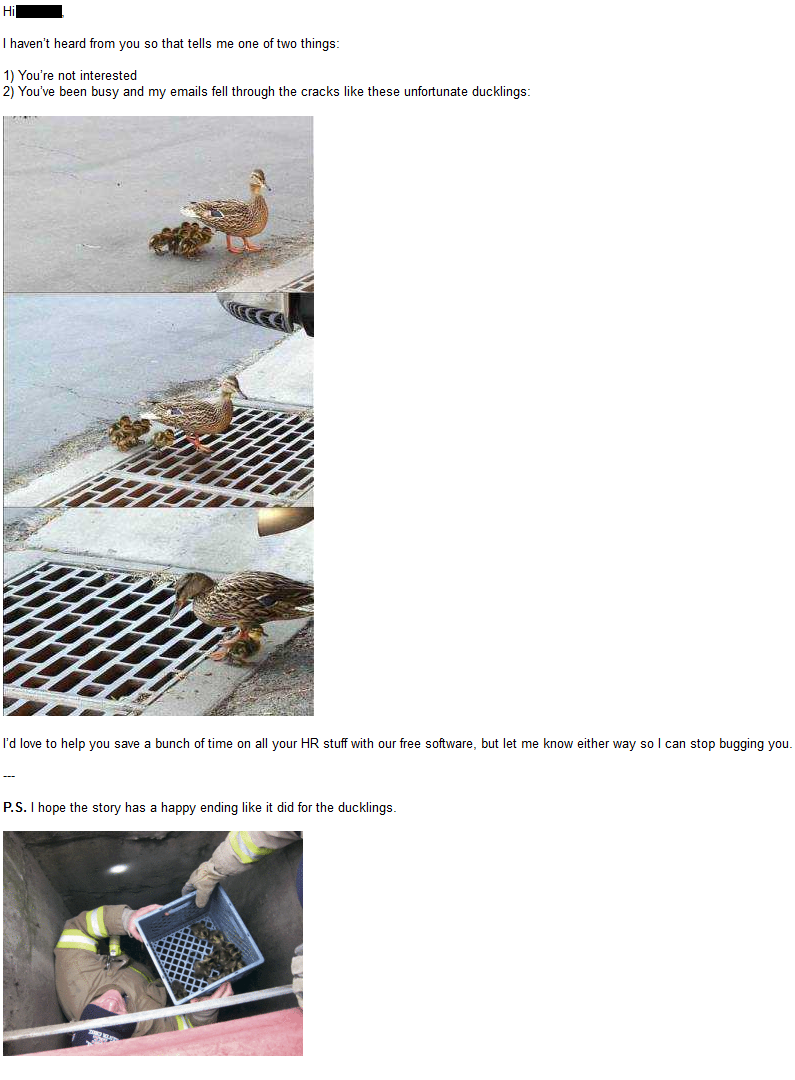
Es gibt unzählige Möglichkeiten für GIFs, Memes und einfach gute alte Texte. Werden Sie einfach kreativ und schauen Sie, was hängen bleibt.
Jemanden zum Lachen zu bringen, ist der kürzeste Weg, um mit jemandem in Kontakt zu treten, und hebt Sie von jeder "Ich wollte nur sichergehen, dass Sie immer noch an der Sache interessiert sind"-E-Mail da draußen ab.
11. Setzen Sie immer Ihr schönstes virtuelles Lächeln auf
Für die meisten Menschen ist ihr E-Mail-Posteingang ein nicht enden wollender Strom der Frustration. Er quillt über vor ungelesenen E-Mails und ist eine nicht enden wollende To-Do-Liste.
Schüren Sie ihr Unbehagen nicht noch, indem Sie sie beschimpfen, wenn sie nicht auf Sie antworten. Dinge wie "Ich habe Ihnen bereits 3 E-Mails geschickt" oder "Sagen Sie mir einfach, dass Sie nicht interessiert sind" werden nur nach hinten losgehen. Ihr potenzieller Kunde fühlt sich wahrscheinlich schon schuldig, weil er Ihnen nicht geantwortet hat; wenn Sie ihm ein schlechtes Gewissen machen, wird sich die Situation nicht ändern.
Ändern Sie die Dinge und betrachten Sie dieses Gefühl der Angst als eine Chance. Seien Sie der größere Mann und verhalten Sie sich einfach gleichgültig, wenn Sie zuvor "ignoriert" wurden. Vermitteln Sie weiterhin eine positive Ausstrahlung und Verfügbarkeit. Ihr potenzieller Kunde wird Ihnen gegenüber positive Gefühle entwickeln, wenn Sie ihm das Gefühl vermitteln können, dass er sich wohl fühlt, während er sich vorher ängstlich fühlte.
Betrachten Sie jede Interaktion als eine neue Chance, eine Beziehung aufzubauen, indem Sie durchgehend positiv sind.

Rekapitulation
Ganz gleich, ob Sie dies bei Kaltakquise oder während des gesamten Verkaufsprozesses tun: Das Nachfassen bringt Ihnen mehr Umsatz.
- Es tatsächlich zu tun, ist das Wichtigste überhaupt. Verstehen Sie Schweigen nicht als Ablehnung. Das Spiel kann nur mit "Ja" oder "Nein" enden. Alles andere bedeutet, dass du aufgibst.
- Um mehr zu erreichen, sollten Sie alles automatisieren, was nicht von Ihnen selbst erledigt werden muss, und ein effizientes CRM-Tool verwenden, damit Sie immer den Überblick behalten. Jeder einzelne Interessent verdient Ihre äußerste Geduld, Ihr Einfühlungsvermögen und Ihre Verfügbarkeit, und das können Sie ihm nicht bieten, wenn Sie die ganze Zeit mit sinnloser Verwaltungsarbeit beschäftigt sind.
- Bleiben Sie am Ball, aber wissen Sie, wann Sie aufhören müssen. Dreimaliges Schweigen ist nicht unbedingt gleichbedeutend mit Ablehnung, fünfmal aber sehr wahrscheinlich schon. Es geht nicht darum, dass Sie Ihren Interessenten nicht verärgern, sondern darum, dass Sie Ihre Zeit den qualifizierteren Interessenten widmen.
- Verringern Sie die Häufigkeit Ihrer E-Mails mit fortschreitender Zeit. Wenn Ihr Interessent innerhalb einer Woche nicht auf die ersten drei E-Mails geantwortet hat, ist er wahrscheinlich nicht in der Lage, mit Ihnen in Kontakt zu treten. Wenn Sie kurz darauf eine vierte E-Mail senden, werden Sie ihn eher verärgern, als dass Sie etwas ändern.
- Spielen Sie jedoch das lange Spiel. Wie man so schön sagt: Ihr Wert ist Ihr Netzwerk. Selbst wenn Ihr Wert für einen potenziellen Kunden nicht unmittelbar relevant ist, wissen Sie nie, wie Sie sich in Zukunft gegenseitig helfen können. Bedeutsame Beziehungen bringen Sie weiter, im Geschäft und im Leben.
- Verlassen Sie sich nicht darauf, dass Ihr Gehirn weiß, wann Sie nachfassen müssen, es wird Sie im Stich lassen. Setzen Sie stattdessen Erinnerungshilfen ein und automatisieren Sie Routine-E-Mails vollständig.
- Nutzen Sie Ihren Verstand, um mit Ihrem Interessenten ins Gespräch zu kommen. Finden Sie heraus, wie sie ticken, stimmen Sie Ihre Botschaft auf ihren speziellen Fall ab und heben Sie sich mit Humor von der Masse ab. Führen Sie sie durch ihre eigene Geschichte und zu Zwischenzielen.
- Und schließlich sollten Sie sich nicht auf E-Mails beschränken, um eine Beziehung zu einigen Personen aufzubauen. Es gibt so viel mehr.
Die Person auf der anderen Seite ist ein menschliches Wesen wie Sie. Wenn Sie in der Lage sind, sich in seine Lage zu versetzen und ihm einen relevanten Nutzen zu bieten, sollten Sie sich durch nichts davon abhalten lassen, weiterzumachen. Haben Sie nie ein schlechtes Gewissen, weil Sie Menschen helfen wollen.
Möchten Sie mehr über die Möglichkeiten der E-Mail-Automatisierung erfahren? Sehen Sie sich diese Video-Anwendungsfälle für E-Mail-Workflows unserer Kunden an.
Zuletzt aktualisiert:
- Die 20 besten Verkaufsbücher, die Elon Musk wahrscheinlich liest - 14. Februar 2023
- 6 narrensichere Wege, wie Ihr Startup seine ersten 100 Kunden bekommt - 6. Dezember 2022
- Wie man einen Verkaufstrichter aufbaut, der verkauft - 2. September 2021
